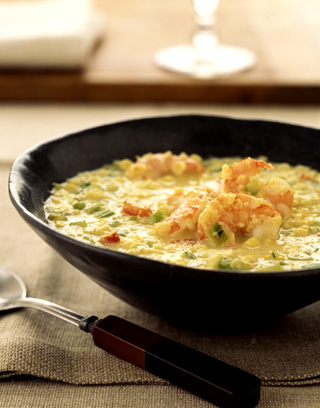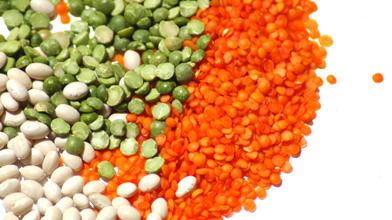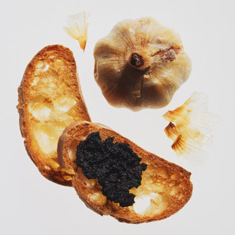Recipes: Appetizers and Soups
In this section on Appetizers and Soups, you can find the following recipes:
Soups
- Amaranth, Quinoa, and Corn Chowder
- Southern Split Pea Soup with Ham (pressure cooker recipe)
- White Bean Gazpacho (pressure cooker recipe)
- Orange Squash Soup (pressure cooker recipe)
Appetizers
Amaranth, Quinoa, and Corn Chowder
Serves 6
Ingredients indigenous to the New World, like amaranth, quinoa, and corn, have a natural affinity. In this soup, the amaranth and quinoa add substance and subtle flavor variations to the more familiar taste of sweet corn.
Ingredients
3 tablespoons butter
1 1/2 cups finely chopped leeks (white and light green parts)
1 cup finely diced celery (remove “strings” by peeling celery before dicing)
1/2 cup finely diced red bell pepper
1 teaspoon salt, or to taste
1/4 cup amaranth
1/2 cup quinoa, thoroughly rinsed
1/4 teaspoon dried thyme
4 cups fresh or defrosted, frozen corn kernels
1 cup whole milk
2 tablespoons minced parsley

Photo by David Prince
Copyright © 2006 Lorna Sass
Instructions
In a large, heavy pot, melt 2 tablespoons of the butter over medium-high heat. Stir in the leeks, celery, red bell pepper, and 1/4 teaspoon salt. Cook, stirring frequently, until the vegetables are soft, about 5 minutes.
Stir in the amaranth and 3 cups of water. Bring to a boil over high heat. Stir in the quinoa and thyme. Return to a boil. Reduce the heat slightly and cook at a gentle boil, partially covered, for 10 minutes.
Meanwhile, in a blender or food processor, puree 3 cups of the corn kernels with 1 cup of water. When the quinoa has cooked for 10 minutes, stir the corn puree and remaining whole corn kernels into the soup. Add salt to taste. Reduce the heat and simmer until the quinoa and amaranth are tender, 3 to 5 more minutes. When the quinoa is done, there will be no starchy white dot in the center of each grain, and some of the germs’ “tails” may unfurl and float freely. On close inspection, the amaranth will look like tiny opaque bubbles floating on the surface.
Stir in the milk and remaining tablespoon of butter. Divide into portions and garnish each with a little parsley.
Note: The soup thickens on standing; thin as needed with additional milk and add salt to taste.
Variations
For dots of color, use 2 tablespoons of red quinoa and a scant 1/2 cup ivory quinoa. Add the red quinoa when you add the amaranth.
Use half-and-half or heavy cream instead of milk.
Use dried tarragon instead of thyme.
Shrimp, Corn, and Quinoa Soup: Instead of water, use 4 cups of fish or clam broth. Use oregano instead of the thyme. Once quinoa is tender, add 1/2 pound peeled, small shrimp. Cook until the shrimp turn pink, about 1 minute. Omit the milk.
Southern Split Pea Soup with Ham
Serves 6
 Making split pea soup in the pressure cooker is a special treat: the peas dissolve into a comforting puree, saving you the nuisance of using a blender. The soup thickens and develops a surface “skin” after standing. Stir well and thin with water or chicken broth, as needed.
Making split pea soup in the pressure cooker is a special treat: the peas dissolve into a comforting puree, saving you the nuisance of using a blender. The soup thickens and develops a surface “skin” after standing. Stir well and thin with water or chicken broth, as needed.
When shopping for split peas, look for ones with bright color. Faded peas mean faded flavor.
10 minutes high pressure plus natural pressure release
Ingredients
1 tablespoon butter or oil (needed to control foaming)
2 cups coarsely chopped onions
2 large ribs celery, diced
8 cups water
1 pound (2 1/2 cups) green split peas, picked over and rinsed
1 pound smoked ham steak or pork butt, cut into -inch chunks
2 large bay leaves
1 teaspoon salt, plus more if needed
1/2 to 1 teaspoon dried thyme (optional)
Instructions
Heat butter in a 6-quart or larger cooker. Stir in the onions, celery, water, split peas, ham, bay leaves, and salt.
Lock the lid in place. Over high heat bring to high pressure. Reduce the heat just enough o maintain high pressure and cook 10 minutes. Turn off the heat. Allow the pressure to come down naturally. Remove the lid, tilting it away from you to allow steam to escape.
Remove the bay leaves. Add the thyme (if using) and simmer until its flavor pervades the soup. Stir well, taking care to blend in the peas that have sunk to the bottom. Add additional salt to taste, as much as 1 teaspoon, if needed.
Copyright © 2006 Lorna Sass


